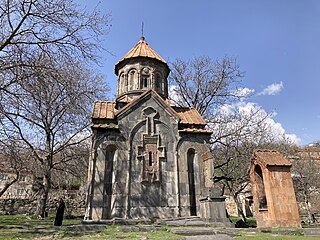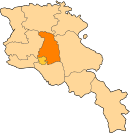
Ararat is a province (marz) of Armenia. Its capital and largest city is the town of Artashat.

Kotayk, is a province (marz) of Armenia. It is located at the central part of the country. Its capital is Hrazdan and the largest city is Abovyan. It is named after the Kotayk canton of the historic Ayrarat province of Ancient Armenia.

Oshakan is a village in the Ashtarak Municipality of the Aragatsotn Province of Armenia located 3 kilometers southwest from Ashtarak. It is well known to historians and pilgrims of the Armenian Apostolic Church as the site of the grave of Mesrop Mashtots, the inventor of the Armenian alphabet.

The Garni Gorge is situated 23.3 kilometres (14.5 mi) east of Yerevan, Armenia, just below the village of the same name. The Garni Gorge is protected by law and listed as a natural monument. On a promontory above the gorge the first-century AD Temple of Garni may be seen. Before Armenia converted to Christianity in 301 AD, Greek gods were worshipped at this temple. Along the sides of the gorge are cliff walls of well-preserved basalt columns, carved out by the Goght River. This portion of the Garni Gorge is typically referred to as the "Symphony of the Stones." It is most easily reached via a road that leads left down the gorge just before reaching the temple of Garni. Another road leads to the gorge through the village, down a cobblestone road, and into the valley. Once in the valley, turning right will lead to Garni Gorge, an 11th-century medieval bridge, and the "Symphony of the Stones". Taking a left will lead along the river past a fish hatchery, up to the Khosrov Forest State Reserve, and a little further Havuts Tar Monastery.

The Azat is a river in the Kotayk Province of Armenia. Its source is on the western slope of the Geghama mountains. It flows through Garni, Lanjazat and Arevshat, before reaching the Aras near Artashat. The main purpose of the Azat dam is to serve for irrigation and hydro power generation. Its hazard potential is ranked to be high.

Armenian architecture comprises architectural works with an aesthetic or historical connection to the Armenian people. It is difficult to situate this architectural style within precise geographical or chronological limits, but many of its monuments were created in the regions of historical Armenia, the Armenian Highlands. The greatest achievement of Armenian architecture is generally agreed to be its medieval churches and seventh century churches, though there are different opinions precisely in which respects.

Bjni, is a village in the Kotayk Province of Armenia. It is situated in a valley between canyon walls and a small river. The village is one of the prominent centers of education and culture of ancient and medieval Armenia. It is the birthplace of the 11th-century scholar Grigor Magistros.

Arzakan, is a village in the Kotayk Province of Armenia. The Aghveran resort is located in Arzakan. There are the large ruins of the 10th- or 11th-century Neghutsi Vank, located along a ravine to the northwest of the village. There are also the 13th-century monastic ruins of Ghuki Vank and 13th-century ruins of Surb Gevorg in the vicinity.

Goght is a village in the Kotayk Province of Armenia, located on the right bank of the upper-Azat River. It is known from 13th-century manuscripts as Goghot. It is located near Garni and sits along the road leading to Geghard Monastery. The village has a small ruined basilica from the 17th or 18th century located straight down a dirt road from the main square. Some khachkars are built into the exterior walls of the church, as well as at its altar. Goght sits overlooking a large gorge and upon a promontory on the other side is the 11th- to 13th-century monastery of Havuts Tar. It may be reached by foot from the town, but more easily from Garni via the Garni Gorge. The community has a school, kindergarten, house of culture, and a library. The local economy is heavily dependent on agriculture, based primarily on grain farming, orchard cultivation, and cattle-breeding.

Makravank is an Armenian church-complex located in the Makravan district of Hrazdan, the capital of Kotayk Province, Armenia. The monastic complex includes a half-ruined 11th-century chapel. The 13th-century church dedicated to Surb Astvatsatsin has a circular tambour and a conical cupola. The complex also includes the lower walls of the gavit and a medieval cemetery.

Makenyats Vank is a 9th–13th century Armenian monastery located 5 kilometres (3.1 mi) south of Lake Sevan in the village of Makenis in the Gegharkunik Province of Armenia. The monastery was founded in 851 with the construction of the central S. Astvatsatsin Church by Prince Grigor Supan II, the son of Princess Mariam, who was also the founder of Kotavank in Nerkin Getashen, Armenia. Makenyats Vank served as a major cultural and educational center for the medieval province of Gegharkunik.

Havuts Tar is an 11th to 13th century walled monastery, situated upon a promontory along the Azat River Valley across from the villages of Goght and Garni in the Kotayk Province of Armenia. It is easily reached via the Khosrov State Reserve, located across the Garni Gorge. The Havuts Tar Trail leads directly from the east side (left) of the reserve entrance to the monastic complex. An alternate route/shortcut to the monastery can be found at the end of the main road along the Azat River and just past the fish hatchery ponds.

Mashtots Hayrapet is a church located within the village of Garni in the Kotayk Province of Armenia. It was built in the 12th century at the site of what was formerly a pagan shrine. A stone carved from red tufa is situated at the right of the entrance to the grounds upon a low rock wall. Upon it is the design of a bird perched on a floral stem with the rosette of eternity under its tail; the latter being a distinctive pagan symbol representing the sun or the moon, symbolizing the eternal cycle of life, death, and rebirth. It is said that because of this pagan symbology, this stone has a connection to the prior shrine.

Kakavaberd or Kaqavaberd, also known as Geghi Berd, Keghi Berd or Kegh, is a fortress on a ridge overlooking the Azat River gorge at Khosrov Forest State Reserve in Ararat Province, Armenia. Kakavaberd is 1,516 metres (4,974 ft) above sea level.

Aghjots Vank ; also known as the Saint Stephen Monastery of Goght, is a 13th-century monastery situated along a tributary of the Azat River Valley within the Khosrov State Reserve located half a mile walk from the hamlet of Mets Gilanlar, and near the villages of Goght and Garni in the Ararat Province of Armenia. Not far from this location and also within the reserve is the fortress of Kakavaberd and the monastic complex of Havuts Tar.

Jukhtak Vank is an 11th– or 12th-century monastery situated in a clearing within Dilijan National Park, 3.2 km northwest from the town of Dilijan in the Tavush Province of Armenia. It sits in close proximity to the church of Matosavank as well as a cemetery that surrounds the church.

Neghuts Monastery is a monastery founded in the 10th or 11th century, situated in a clearing on a hillside overlooking a valley and the village of Arzakan in the Kotayk Province of Armenia. The monastery is located approximately 2 kilometres (1.2 mi) northwest of the village center. There are other churches in the vicinity, most notably the 13th-century monastic/church ruins of Ghuki Vank, the church ruins of S. Astvatsatsin (1207), and the 13th-century ruins of Surb Gevorg.

Khosrov Forest State Reserve, is a nature reserve in Ararat Province of Armenia. The reserve is one of the oldest protected areas in the world having a history of about 1,700 years. It was founded in the 4th century (334–338) by the order of king Khosrov Kotak, who gave it his name. It was founded to improve the natural climatic conditions of adjacent territories of Artashat – the capital city of Armenia of the given period and the newly established city of Dvin to ensure conservation and enrichment of flora and fauna; serve as a ground for royal hunting, military exercises and entertainment.

Araratian Pontifical Diocese is the largest diocese of the Armenian Apostolic Church and one of the oldest dioceses in the world, covering the city of Yerevan and the Ararat Province within Armenia.

Diocese of Kotayk, is a diocese of the Armenian Apostolic Church covering the Kotayk Province of Armenia. The name is derived from the historic Kotayk canton of Ayrarat province of Armenia Major.


































